Forum Replies Created
-
AuthorPosts
-
 Tony RoddaParticipant
Tony RoddaParticipantYes David, there are substantial benefits. Even better if you use the right LEDs.
 Tony RoddaParticipant
Tony RoddaParticipantHi Peter, the health issues seem to be quite severe, so much so that several US cities reversed their iimplementation programme. If you haven’t watched Dr Mario’s presentation (available on the BAA website) I urge you to do so.
Regards
 Tony RoddaParticipant
Tony RoddaParticipantHi Peter, the health issues seem to be quite severe, so much so that several US cities reversed their iimplementation programme. If you haven’t watched Dr Mario’s presentation (available on the BAA website) I urge you to do so.
Regards
 Tony RoddaParticipant
Tony RoddaParticipantHi Andy,
I’m only getting the first few slides of Mario Motta’s presentation.
Is it loaded incorrectly or am I dopey?
PS, See my dark skies plea posted elsewhere…
Regards
T
 Tony RoddaParticipant
Tony RoddaParticipantAndy,
From memory…
‘run’ in the command/dos window… “gpedit.msc”. This opens the Group Policy window
Pick the folders … Computer Configuration >> Administrative Tools >> Windows Components
Double click “Configure Automatic Updates” and select the radio button required.
Don’t forget to save.
Regards T
 Tony RoddaParticipant
Tony RoddaParticipantAs per William’s post, I find AIP runs fine as long as you follow the patch procedure. Out of habit I ‘run as administrator’ and it seems to fire up OK.
I’m a devotee of SG Pro2. Fab program.
Carte du Ciel (Skycharts) is an amazing free prog too.
Tony
 Tony RoddaParticipant
Tony RoddaParticipantAnother photometry application put to good use and within amateur capabilities too.
There should be good pro-am citizen science opportunities.
 Tony RoddaParticipant
Tony RoddaParticipantGood advice, as ever. I had seen Christian’s pages but hadn’t picked this up.
Regards
 Tony RoddaParticipant
Tony RoddaParticipantAll the holders, etc printed (in PETG-Carbon) for the ‘over-sized’ 600 l/mm grating, collimation lens and Camera lens. Additional grating holders for other l/mm too. PETG with carbon is an excellent material but a b***er to print with, but getting there. still experimenting with printer settings.
‘Calibration’ circuitry complete and running for Neon and Relco. The latter after adding a diode voltage amp phase to the existing voltage multiplication chain, blowing a few components and swearing a great deal. It’s a good thing the Chinese sell 50 components for tuppence. This is now “miniaturized” and boxed (See photos) although not fully fitted – a few print/design issues to work through properly. (Its miniature by virtue of the fact my initial attempt was three times larger than it needed to be). I’ve added a manual ‘screen’ that can be inserted in front of the slit to reflect calibration bulbs. Works but not completely sorted – on the right lines. (This only works for the ‘ALPY’ slit. Not enough room in the ‘guiding chamber’ when the OVIO holder is fitted).
A couple of cameras rigged purely for initial alignment but showing nice sharp emission lines across the spectrum. Lots of messing about with lens positions of course and (back) focus is tight. I’ve drilled and inserted grub screws into the camera interfaces for security.
I’ve been ignoring the real observing ‘work’ and am taking a break to catch up but I plan to put the basic LowSpec on the ‘scope the next chance I get.
Regards
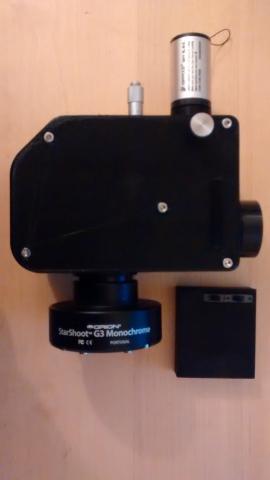
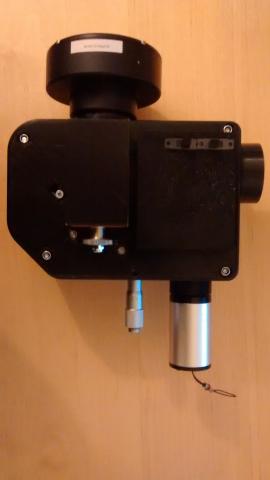
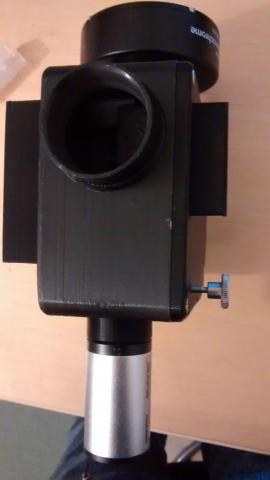
 Tony RoddaParticipant
Tony RoddaParticipantNick, A Wanhao i3Plus, and yes, it’s a fantastic new manufacturing ‘additive’ process. I’m sure as new materials are added by suppliers then everyone will embrace the concept. I chose the Rhino because its very well made and a mature product with good support and a good sized community. Probably not the biggest print bed on the market but very easy to use.
Paul, the whole thing took a week – but that was mainly due to other things such as wife, kids, life needing attention. They were the ones screaming for mercy!!! Probably three full days but nothing compared to the time i’d need to acquire, learn, perform lathe/metal work skills!
Yes, high infill levels and ‘thick’ walls. A small price to pay for the rigidity and the extra benefit of being able to drill, file, sand, tap, etc. See below.
Version 1 finished, fitted and optics, as per PG’s configuration, ready to assemble tomorrow. SimSpec seems to suggest a resolution of above 2,300 for the config below. (If I’m inputting/reading SimSpec correctly). Tee only ‘upgrades’ being metal interfaces.
Version 2, in ABS, printing now and almost complete with all the optics,etc assembled for several more configs to stretch the design. I know I’m running before walking but its fun. The higher gratings, larger lenses etc within the same physical config (body machined to accept greater grating rotation, etc) when input to SimSpec suggest resolution from 5,000 all the way up to 9,000+ but that requires an almost fixed config. Lots of drawbacks but I just want to see what happens. Beamsplitters instead of guiding mirrors, etc.
I can test transparency, thermal expansion and general stability along with mechanics for the two materials.
And I have a working calibration unit for Neon needs mounting. I have a strong suspicion that I’ll be able to fit tungsten and Relco bulbs too. The parts bin gets bigger but a least I can print more parts bins…
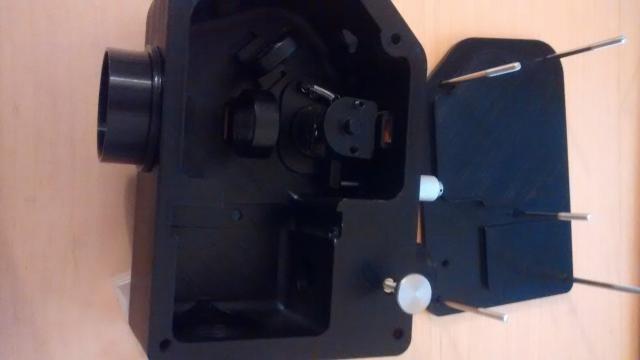
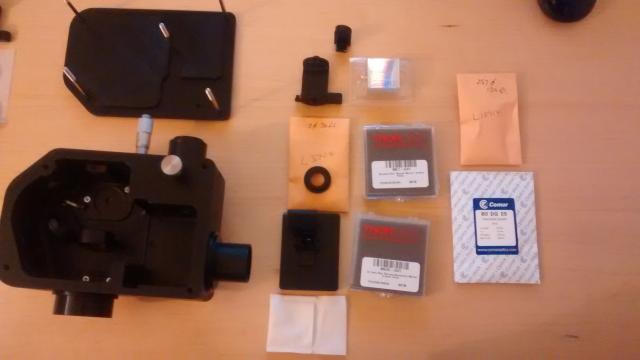
 Tony RoddaParticipant
Tony RoddaParticipantT
 Tony RoddaParticipant
Tony RoddaParticipantWill you post your progress Grant?
T
 Tony RoddaParticipant
Tony RoddaParticipantHi Grant, I posted my recent attempt in a separate thread a while back. A good quality 8×9 internal dimension tongue + groove to replace a Skyshed POD. £460. The pent roof is the standard shed covered with ‘non-breathable’ rubber roofing membrane – 1/20 the weight of felt and has withstood several storms, snow, ice, etc. If it does deteriorate in some way I reckon it’ll take all of 15 minutes to renew but it hasn’t shown any such signs. Completely waterproof.. The roll of membrane cost £18 for 45 metres from Eurocell – lots left! I’d tried the plastic corrugated roofing (B&Q) in a fold out config in pre-POD days but had difficulty maintaining seals.
As the guys above say, because the roof is slightly raised (in my case B&Q angle iron runners and lots of simple castors) there’s great airflow compared to the POD. Zero consensation and I’ve never used my dehumidifier. The shed stands on tantalized bearers on a concrete slab – so good airflow underneath. I lined the internal walls with “Jablite” foam, again from B&Q and covered with the membrane for a sealed finish. The result is good airflow but well insulated.
I offset my pier (with CGEM and C925) and there’s still room for a CPC800 with wedge plus a partitioned corner for the PCs. A bit of a squeeze but workable.
The only downside is a neighbours “security” light, that was masked by the POD is now (just) visible and needs a bit of board wedged on one end when it triggers.
The supports for the roof fold in-out to keep her-indoors happy.
Hope this helps.
Tony
 Tony RoddaParticipant
Tony RoddaParticipantWell done Alun, that’s a neat mod.
Is there much weight added or vibration?
Regards Tony
 Tony RoddaParticipant
Tony RoddaParticipantI agree entirely with the comments.
As Robin stated present this is a great prototyping tool but I’m looking forward to better materials and a composite metal/ABS design perhaps. I’m keen to explore the possibilities. Certainly not suggesting it’s a replacement for existing kit at this stage.
Really keen to test though and hence the plan to print a number of designs/platforms.
Dominic, yes I think this will be finalised in ABS (at present). I’ve left a couple of PLA ‘block’ prints in the obsy to test exposure. I’m printing at 0.1mm and Paul’s design is superb, everything fits with minimal finishing/adjustment. May I ask what spectro design did you try?
I think with additional layers of paint may help IR/transparency in general.
With luck it’ll be fully assembled this weekend. Hope ‘her indoors’ has no plans!
Regards
T
 Tony RoddaParticipant
Tony RoddaParticipantYes Andrew, lots of questions about strength, stability, etc. but we have to start somewhere and even my little printer duplicates in about six different materials. There’ll be one (or more) that proves suitable.
Plus, as you say, it’s the manufacturing process that is revolutionary but if we need a part that needs high strength (and say “Carbon” won’t do) such as the ‘scope end plate that takes a lot of weight, then I can make specific/individual parts in metal or buy/adapt ready available screw adapters. But that’s a bit of plate work – you don’t need an experienced lathe operator for the complex stuff. (McClaren are printing complex gas flowed inlet manifolds in titanium if you fancy a £500k printer but that defeats the object!).
My current ‘production run’ is only to construct test beds. One to use and evaluate the actual practicality and accuracy of the spectra produced (and it’s resolution, etc.) in various materials and one to ‘hack about’ with different lenses/grating, etc. I hope to do that for each design ‘out there’.
I produced three small ‘blocks’ of material with identical dimensions except for wall thickness and infill density. Then carried out a very scientific test called ‘hitting it with a two pound hammer’. (OK a bit more controlled – identical drop height, etc). I increased the wall depth but kept the infill to 80% on one block as per PG’s instruction and had to physically pick up the hammer and belt it two or three times to destroy it. I’m printing larger parts this week so I’ll begin testing rigidity, etc. If, in the end, I have to brace the sides with one or two metal struts (Meccano style) or thicken sides/bases, etc I’ll do that.
As for the chemical /photo stability of PLA, ABS, etc I think a bit of practical use and testing will point the way.
I think a composite will be a short term reality and the dramatically cheaper cost will tempt more people into trying more serious spectroscopy before a large outlay is required.
Regards
Tony
 Tony RoddaParticipant
Tony RoddaParticipantI used a QHY5 II L Colour with PHD2 without much difficulty on a C925+0.63 reducer.
A 1.5 or 2 sec exposure worked well and didn’t over-correct for seeing.
This gave enough stars to easily id the field using Guide9.
However, I soon moved to a Lodestar and would echo the sentiments above. Big improvement in sensitivity.
My pointing accuracy on a CGEM (albeit hyper-tuned) using Guide9, Astroplanner or CdC puts the target in the guider fov, even after a flip. (I should point out I never slew at the highest speed). Although I still use a secondary finder-guider for comfort as David mentioned!
The only downside from the using the Lodestar was a slightly smaller field than the QHY.
Good luck and stick with it. Just practice really!
Regards
T
 Tony RoddaParticipant
Tony RoddaParticipantThanks, Robin. Once again.
Paul’s design and manufacture are impressive although I can’t afford his printer >£2,000.
I might as well buy the real thing at that price! And unless you want a UVEX why not go the extra mile and do a LHiressIII?
I think the sides/case could be aluminium for strength/rigidity. Being plate work it’s relatively easy and avoids a big ‘print job’. That means a smaller printer and associated costs.
Internals are printable which are the difficult bits from an engineering point of view. It also allows experimentation.
Add a few off-the-shelf bits and perhaps this is eminently doable. I’ll pursue that plan.
I think a printer (& software) for Christmas is in order. Need to brush up on the printing methods.
PS. You’re up in my neck of the woods in a couple of weeks for the Newcastle Astro session. If you fancy a pint before or after let me know and I’ll show my appreciation in the usual manner!
Rgds
T
 Tony RoddaParticipant
Tony RoddaParticipantThanks for the info gents. Very useful.
There’s a few good ideas regarding a design so I’m happy that this can be done. It’s the actual manufacturing that I’ve yet to get to grips with.
I went off on a tangent when a friend of mine suggested 3D printing.
I’m guessing that the actual spectro case should still have to be fabricated out of something very rigid such as metal or, as suggested, ply but the ‘fiddly’ stuff should be eminently ‘printable’. That means the ‘flat’ plate-work is relatively easy and the 3D printing overcomes machining and lathe work.
It’s extremely cost effective (even though the machining isn’t actually as expensive as I thought to get done locally).
This must have been suggested or thought of before. Anyone done this?
Regards (and many thanks for the input).
 Tony RoddaParticipant
Tony RoddaParticipantRobin, et al,
What’s the chances of a Lhires, L200, etc (kit or commercial) becoming available? Have you ever seen such an occurence?
Working or otherwise. Just thinking about how to get a head start and even a ‘re-build’ project. Something to help me learn the design/engineering without just buying one off the shelf.
Regards
T
-
AuthorPosts
